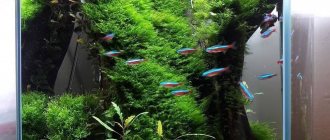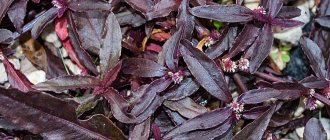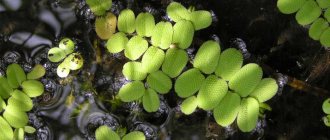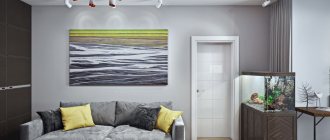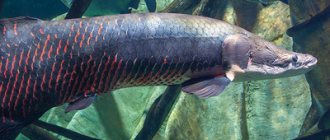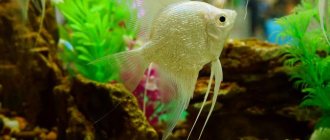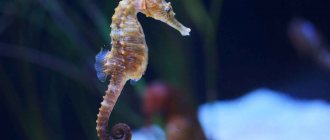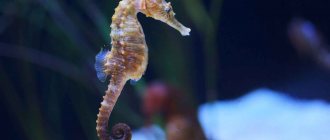The word “paludarium” is formed by analogy with the words “aquarium” and “terrarium” and literally means “container for a swamp.” Consequently, a paludarium is a reservoir where half, most or all of the bottom area is occupied by a reservoir.
- Anubias
Paludarium - indoor water garden
Paludarium is one of the most original ways to bring living plants into the interior. And the point is not only that creating such a water garden and maintaining it requires considerable effort. A paludarium is an entire closed ecosystem that imitates a full-fledged water body and is intended for growing water-loving crops. And if earlier paludariums were truly “a toy for the elite,” modern technologies have once again revived interest in them and turned them into one of the most fashionable varieties of florariums.
Paludarium. © DasKnocker
Content:
Paludarium is a swamp, but not quite
Paludariums are water gardens in the interior. Despite the fact that their name comes from the Latin paluda (swamp) and arium (place), they should not be considered just indoor swamps. The essence of these complex ecosystems, which are transparent reservoirs with an artificially created habitat for maintaining aquatic plants, is perfectly evidenced by their nicknames. Among gardeners, paludariums are known both as aquariums for plants, and as indoor swamps, and as water greenhouses or swamp terrariums.
In essence, a paludarium is a greenhouse enclosed in a vessel with high humidity conditions for specific moisture-loving crops, a kind of hybrid of a florarium and a portable pond or aquarium. Paludariums combine three elements - earth, air and water.
The paludarium is certainly an aesthetic and atmospheric object: it affects the mood in the same way as garden ponds and any other water bodies, bringing calm, relieving stress, relaxing, setting the mood for rest and promoting complete relaxation.
This is one of the most effective objects that harmonize space, which sets the mood and allows you to experience all the delights of communicating with nature without leaving your home. In fact, it is an original piece of aquatic plant life in your home. But paludariums have other advantages:
- they are one of the best means of air humidification, similar in effect to any industrial humidifier;
- despite their growing popularity, paludariums remain one of the most unusual and elite landscaping options;
- they allow you to realize the dream of your own water garden, even if you do not have a suburban area;
- You can grow the most capricious plants in them.
Paludariums allow you to imitate natural bodies of water or their individual fragments. Their arrangement is always guided by idealized landscapes - views of a flooded forest, floodplains, island stone beaches, river banks and mountain streams. Depending on your idea of an ideal water garden, paludariums can even imitate a waterfall, steep cliffs, ledges, and multi-level ponds.
Paludariums are an option for an aquatic florarium, which is suitable not only for those who love water gardens and objects and have experience in maintaining an aquarium. Of course, having some practical training will not hurt, but if you dream of your own paludarium, then with enough diligence you will achieve success even without experience. Moreover, aquarists will always be able to advise you.
But when deciding to start even a small paludarium, be prepared for the fact that you will have to take care of it: unlike a regular florarium, which stands out precisely for its ease of care, an aquatic terrarium requires constant attention.
Paludarium. © gy960
Structure of an indoor water garden
Any paludarium consists of two parts - water (submersible) and ground (or coastal). Their ratio is practically unlimited and can be chosen at your discretion and purely on aesthetic principles, selected according to your taste and desired plants. But the dry or coastal zone in paludariums should at least slightly dominate the water one.
Despite the possibility of improvisation, the principles of arrangement of all paludariums are identical:
- At the bottom of the container there is a layer of soil or soil in which aquatic plants are planted. The soil can be very different - a disinfected universal substrate, a mixture of leaf soil and gravel in a ratio of 1 to 3 with the addition of crushed coal, or special soil for water gardens and an aquarium.
- The space of the paludarium is divided into water and coastal parts - a partition is installed and the “shore” is filled with drainage, fertile and decorative soil, creating dry land. Usually it is placed at the far wall of the container or shifted to one of the corners. Using plastic, glass or mesh partitions, the paludarium can be divided into a larger number of separate zones, like a garden pond.
- Plants are planted: aquatic - directly into the soil at the bottom, but terrestrial or indoor - placed either in the soil of the coastal zone, or in containers, which are additionally decorated and covered. When planting in the soil, you need to make sure that the water does not “drown” the roots too much. Placement in pots is preferable: in this case, it is much easier to remove damaged crops, and you can change the design of the garden to your liking (not to mention the fact that caring for the paludarium is simplified).
- The water part is filled with clean water (suitable for aquariums) to the desired level.
Creating a design
The basis of the entire structure is a glass aquarium - this is where the aquatic environment will be located. There are two ways to make a background:
Styrofoam. The foam is cut to the required size. Using a heated soldering iron, it is given a relief appearance. Then it is painted in the desired color. In this case, you should use non-toxic paint that will be harmless to fish and plants.
Using sealant, you can attach moss, driftwood, volcanic chips and many other decorative elements to the foam to recreate a natural tropical biotope.
Polyurethane foam. Sand and foam are mixed in the required proportions. The solution is placed into the formwork and the required pattern is formed. After drying, you can easily saw off the excess parts. Painting follows the same principle as described above.
If you plan to place the garden above the aquarium, then a plywood box is screwed to the wall where it will stand. You can then attach additional containers to it for planting plants. The basis of this entire structure will be an aquarium.
In order to avoid increasing the level of humidity in the room (this can lead to mold and mildew on the wallpaper, tiles, ceiling, etc.), you can install doors.
The technical side of the paludarium
Paludariums are traditionally set up in aquariums, usually rectangular, but sometimes round. The size of the containers can range from the most compact to huge installations that replace walls. The only strict parameter that cannot be violated: paludariums are not placed in containers whose height is less than 50 cm. In pet stores you can buy ready-made kits and even working paludariums.
There are also special containers or installations for paludariums, in which the back wall is made as a shield from materials to which plants can be attached - bark, pebbles, sand, branches. You can make such a background yourself by gluing a sheet of foam plastic with suitable materials, and then securing it in the aquarium with sealant or simply installing it as a background.
The difficulty of arranging a paludarium and maintaining the conditions necessary for plants is the main reason that the aquatic florarium practically disappeared at the end of the last century and only select fans of original floristic solutions and reptiles knew about it. But the main problem of such a “swamp in an apartment”—maintaining humidity, temperature and lighting—is today easily solved by climate control systems. Without at least the simplest installations, paludariums cannot exist. These indoor water gardens require:
- heating the soil (most often it is carried out using special terrarium thermal cords or thermostats);
- filter or pump to saturate water with oxygen;
- backlight;
- ventilation system for completely enclosed paludariums;
- irrigation system (if it is not installed, you will have to manually spray the plants 2-3 times a day).
Equipment in a paludarium is always hidden behind decorative elements. Plants in the terrestrial and sometimes in the aquatic part are “planted” on stones, pieces of bark, branches, roots, and snags. You can purchase ready-to-use fragments of wood and driftwood that have already been processed at any pet store. If you collect decorative fragments of trees in your garden or forest, then you need to treat such a base with boiling water, soak it in an insecticide or saline solution, and then boil or soak it.
Also, other natural materials are used in the design of paludariums - stones, pebbles, aquarium soil. Here they are guided by aesthetic considerations. To create complete images, the composition is often supplemented with ceramic sculptures and figurines, for example, picturesque ruins or “drowned” treasures.
How to create optimal parameters of the aquatic environment for a paludarium
In order for aquarium inhabitants and green spaces to be healthy, beautiful, and fully developed, it is important to take care of creating the most comfortable conditions for their living in the paludarium:
Temperature regime When creating a paludarium, it is important to pay attention to the temperature of both the aquatic environment and the air in the space of the water garden. Optimal temperature indicators range from +24 to +28°C. You can maintain the temperature regime, avoiding its changes, using waterproof heaters equipped with an automatic thermostat, as well as pendant lamps located above the paludarium itself.
Backlight
Most aquatic and emergent plant crops cannot tolerate exposure to ultraviolet rays. Therefore, when creating and installing a paludarium, care must be taken to ensure that it is out of sunlight. To provide the necessary lighting, pendant lamps or simple table lamps are used, which are installed on the sides of the water garden (this option is ideal for small structures). Experts advise using medium-power fluorescent lamps to illuminate the paludarium.
Water level. Whether the paludarium is filled with liquid is a purely individual question. Depending on the wishes of the aquarist, you can use a small amount of water, or, on the contrary, you can create an imitation of a miniature indoor lake in which decorative fish, frogs, mollusks, shrimp and even turtles can live.
Design and decoration can be anything depending on personal taste preferences. In most cases, when creating a paludarium, aquarists use natural decorative elements, such as various stones, driftwood, shells, and corals.
Humidity indicators. Since tropical plants are usually grown in a paludarium, it is important to maintain sufficiently high air humidity levels. For these purposes, you can use specialized spraying systems, miniature fountains and decorative waterfalls, which will also perform an additional decorative function.
Priming. For aquatic crops grown directly in an aquarium, fine soil covering the bottom of the tank with a layer of at least 5 cm is suitable. If you plan to plant greenery in separate containers located above an artificial reservoir, then preference should be given to peat soil, which is recommended beforehand. add some chopped tree bark.
Filtration and aeration are important primarily for ornamental fish and other aquarium inhabitants, although many plants need an increased amount of oxygen and cleanliness of the aquatic environment. Therefore, it is recommended to equip an artificial reservoir with a medium-power filter, as well as a small aerator. In order not to spoil the appearance of the paludarium, it is recommended to give preference to external models of filters and aerators, which should be fixed on the back walls of the artificial reservoir. It is also important to keep the aquarium clean, not forgetting to change the liquid in the tank weekly, at least 30-40% of the total water volume.
Ventilation is necessary for closed structures. In such paludariums, care should be taken to blow through the glass door by making small holes in it. Otherwise, the wall will fog up, which will not allow you to enjoy the beauty of the water garden.
Plants that can be used in paludariums
The range of indoor plants that love swampy conditions and are suitable for paludariums is quite scarce. But when arranging a water garden in an aquarium, there is no need to limit yourself to only indoor crops. In arranging paludariums, you can use the entire range of plants suitable for decorating garden mini-ponds and aquariums.
In the aquatic part of paludariums, cultures that are used in aquariums are usually used - lagenanders , cryptocorynes , anubias . But you can also use garden water crops that you used when designing mini-reservoirs.
Two “obligatory” plants for the ground part of the paludarium are tillandsias and cissus . They are considered classic and almost indispensable crops for the aquarium garden. spathiphyllum , selaginella , ferns , calamus , and aglaonemas are also suitable for decorating a paludarium . If planted in pots, you can use any plants that like high air humidity. Any of the epiphytes can be attached to the back wall.
Look great on bark, branches, stones and decorative mosses . Decorative elements covered with them can be bought at a pet store, or you can grow Java moss and other bryophytes onto various surfaces of the paludarium yourself.
Paludarium
Contents of bucephalandra
They just recently appeared on the market, but many people have already fallen in love with Bucephalandra.
These plants are lovers of swamps and have elegant decorative properties. The following will be useful for keeping Bucephalandra in an aquarium:
- fertilizers to stimulate growth;
- low lighting, thanks to which the plants will become brightly colored and bloom profusely (bucephalandra also blooms very well under water).
It is recommended to dissolve the foliage in case of changing the paludarium and tie the rhizome to the snag when planting the plant. In the case of Bucephalandra, it is necessary to achieve stable water parameters to prevent the leaves from dissolving. In comfortable conditions, it tends to grow with frightening speed and blooms faster, dappling with its milky candles. The bucephalandra can be placed in any part of the paludarium: both on the bottom plane and along the vertical walls, etc.
Bucephalandra can even grow its roots to aquarium stones or other hard surfaces.
Inhabitants of paludariums
Despite the fact that paludariums are considered aquariums for plants, there is also room for animals in their design. Of course, you won’t be able to combine a classic aquarium with a full-fledged water garden, but some fauna will help turn your “wet florarium” into a small miracle. Aquarium snails or frogs will happily settle in the paludarium.
Paludariums are an ideal habitat for animals that need a combination of water, land and plant-loving reptiles of all kinds. But in this case, it is necessary to strictly control the conditions, arrange the paludariums, focusing on the living space the animal needs, and use only materials and plants, the range of which would be approved by the veterinarian. They approach the arrangement of an inhabited paludarium more strictly.
Paludarium care
In each specific case, the care required by the plants and inhabitants of the paludarium is different. The basic components of water garden care include:
- maintaining humidity (without installing automatic systems - spraying up to 3 times a day);
- eliminating the spread of fungi and mold (using distilled water, isolating plants and disinfecting them at the slightest sign of damage);
- timely removal of dry and damaged parts of plants;
- glass cleaning;
- water change (20% of the volume once every 2 weeks);
- fertilizing (the schedule is selected according to the requirements of specific plants).
Plants floating on the surface of the water
1. Common Salvinia (SALVINIA MINIMA) 2. Giant Salvinia (SALVINIA MOLESTA) 3. Pistia (PISTIA STRATIOTES) 4. Water hyacinth (EICHHORIA CRASSIPES) 5. Limnobium LAEVIGATUM 6. WOLFFIA SP. 7. Phyllanthus (PHYLLANTHUS FLUITANS) 8. Riccia (RICCIA) 9. Pemphigus (UTRICULARIA) 10. Azolla fern (AZOLLA FILICULOIDES) 11. Lesser duckweed (LEMNA MINOR)
Benefits of using floating plants:
• Floating plants will give your paludarium a truly wild look. • Create shadow areas. • Additional source of oxygen for fish. Having aerial leaves and an underwater root system, they create circulation of oxygen from the air (where there is many times more oxygen than in water) into the water. • Good dietary supplement for some fish species.
Difference from a regular aquarium
The main difference between an aquarium and a paludarium is that the first is completely filled with water, while the second provides for the presence of dry land. In addition, not only fish, but also reptiles, amphibians, insects and others can live in the paludarium. Another distinctive feature is that various types of plants, including flowering ones, can be grown in an open aquarium.
Flora
In general, all plants for the paludarium are divided into three groups:
- Aquatic plants. Or algae, which live entirely in water.
- Plants partially submerged in water. Their roots are underwater, but the stem and leaves sway on the surface. A striking example is decorative reeds.
- Indoor plants that require high humidity. They grow in separate pots with soil and are located at different levels in the paludarium. Such plants include, for example, fern and spathiphyllum. Many orchid lovers will say that growing this flower in a paludarium is much easier: acclimatization occurs faster in the created conditions.
Plants from the second group can be planted in two ways: directly in the ground or in separate pots.
In the first case, the plants are placed in soil placed at the bottom of the aquarium. Since it is not ideal for plants, granular fertilizers containing clay or peat can be used. Over time, fish and other inhabitants will provide natural fertilizer to the plants. The disadvantage of this type of planting is that the root systems of different plants may become confused.
The second method involves planting each plant in a separate pot. It is better to opt for soft plastic containers that are easy to clean. These pots go to the aquarium. The main advantage of this method is the preservation of the roots. Plants are easy to replace or move, but they will remain intact, and other inhabitants of the paludarium will not be greatly disturbed.
Remember that soft leaves of aquatic plants may be harmed by some fish and turtles.
Return to content
Care and maintenance
To create favorable living conditions for the inhabitants of the paludarium, you need to adhere to the following recommendations:
- Special soil for aquariums or terrariums must be used. You can use a mixture that includes natural ingredients (peat and charcoal). The soil must be checked to ensure there are no unwanted microorganisms in it. To do this, it is heated in the oven.
- It is necessary to use clean water or settle with tap water. The water must be changed frequently to avoid contamination.
- Aquarists advise using at least 1 kW for every 2 liters of structure volume. You can use both fluorescent and special lamps for aquariums. In addition, you can combine different light sources, which will have a beneficial effect on the life of plants. However, you cannot keep the lights on all the time.
- The optimal temperature inside the tank should be maintained at +25…+35°C. The indicator should not be allowed to fall below +20°C.
- The humidity level should be quite high, since it is inhabited by moisture-loving animals and plants; for a paludarium this factor is the most important.
- Representatives of flora growing above the surface of water or soil should be sprayed with water from time to time.
There are many different technical units that make caring for the paludarium easier. If you liked the article, share a link to it on social networks.
How to arrange a paludarium with your own hands: necessary plants, conditions
A paludarium is an artificially made object that imitates living nature, suitable for containing plants and animals. Literally, paludarium is translated as “a container with a swamp.” Creating a paludarium at home is a painstaking and quite expensive task, but the joy of owning a personal ecosystem exceeds all the troubles. A most unusual item - a corner of wildlife - will decorate and enliven any interior and is unlikely to leave anyone indifferent.
The difference between a paludarium and an aquarium
How does a Paludarium differ from a regular aquarium?
In an aquarium, two elements are involved - water and air, while the structure of the paludarium also includes part of the land - earth. This makes it possible to keep in the paludarium not only fish, but also other representatives of the fauna - reptiles, insects, amphibians and others. In addition, the range of plants grown in it is much wider, for example, these can be flowering species.
The combination of three elements in a small area makes the paludarium a truly unique place. Exotic lovers will certainly enjoy keeping an original corner of wildlife at home.
Indoor biotopes
It’s hard to imagine a better corner of nature in an apartment than a paludarium. In addition to near-water flora, it can contain representatives of the animal world from the aquatic and bordering habitats. The design, where an additional part is an aquarium, becomes a miniature model of nature. Here you can make observations, conduct experiments, engage in selection, etc.
Naturalists often combine a paludarium with an aquarium. The result is amazing works of indoor landscape design. They are very beautiful and bring practical benefits. You can relax and have a good rest around it.
How to make a paludarium with your own hands
The design of the paludarium is essentially an aquarium with a removable front glass wall. This function greatly simplifies the maintenance and care of all inhabitants of the ecosystem.
The design of a paludarium is a matter of taste for its owner.
In order to make the background you will need polystyrene foam or polyurethane foam. A piece of foam plastic can be given the required shape using a soldering iron and then painted. You can immediately create the desired relief from polyurethane foam and paint it as well. Choose dyes that are harmless to plants and animals.
The paludarium should maintain a stable temperature of approximately 25 degrees.
The lighting is placed directly above the aquarium itself, but it should not be too aggressive, because most representatives of the flora and fauna of the paludarium prefer partial shade.
A necessary factor for the survival of the inhabitants of an artificial ecosystem is high humidity.
A paludarium with a waterfall will help maintain a suitable microclimate. Technical devices that exist in our time can significantly facilitate the care of the paludarium.
If you plan to place turtles or frogs in a wildlife area, you will need to create a mini pond for them.
For those who do not have the opportunity to make a paludarium with their own hands, you can purchase models in stores or online. Recommended aquariums include the JEBO R660 or Scenic paludarium.
Decor
The design of the paludarium begins with the creation of the back wall. There are several options.
- Ready background. Special panels of different sizes or even a ready-made composition can be purchased in the store.
- Styrofoam. If you want to do it yourself, you can use foam. Take a piece of foam the size of the wall of an aquarium. Using a soldering iron, the desired relief is created. After this, the background must be treated with non-toxic paints or adhesives. The color of the paint can imitate stone - from gray tones to dark brown. Small pebbles, sand, pieces of bark and other materials are poured onto the glue. The panel is placed in the aquarium, attached to the glass with silicone sealant.
- Cardboard box. In this case, the panel will be placed not inside, but outside the aquarium, on the back wall. A cardboard box is made to size, painted on the inside with the desired colors. It can also be covered with colored paper and other materials. Twigs, pieces of bark, and stones are placed inside the box. This background has one drawback: in order for it to always look impressive, you need to regularly clean the rear window.
- Polyurethane foam. To make a foam panel, you will need plastic film. It is spread out on a flat surface, and then foam is applied to it - so that the desired relief is obtained. After the foam dries, a finished panel is obtained. Protrusions and irregularities are cut off with a knife. After this, remove the film, cover the panel with epoxy resin or waterproof paint and place it in the aquarium.
- Stones. You will need stones of different sizes and a piece of plexiglass. Using a sealant, the stones are glued to the glass. The voids can be filled with the same foam, epoxy resin and other materials. If you want to decorate your aquarium with stones, try to choose lighter rocks.
- Combination. Nobody prohibited the use of several design options at once. You can decorate a paludarium using a cardboard box and polystyrene foam, stones and foam - it all depends on your imagination and design idea.
Return to content
Plants for paludarium
Before you set up a paludarium at home, you need to make a list of its future inhabitants - plants and animals.
Nowadays it is not difficult to buy plants for a paludarium in specialized stores. Most often, moisture-loving specimens that grow in the wild on the shore are used for paludariums. Of greatest interest to fans of exotic flora are plants from Africa, Asia and Australia.
The easiest way to plant plants in a paludarium is to use containers made of soft, thin, bendable plastic. The shape and volume of containers should be selected individually for each plant. It would be good if the container had several holes.
Suitable soil is soil mixed with sand or gravel and treated against parasites. Plant feeding should be done infrequently and very carefully so as not to harm the animals kept in the paludarium.
If the method of growing plants in separate containers does not suit you, you can place a five-centimeter raised gravel on the bottom, which will serve as a platform for planting plants.
Anubias
Anubias is a strange and undemanding plant for most people; it will fit perfectly into the space of a paludarium. Caring for Anubias is not difficult - just provide it with an average amount of light and a suitable water temperature - about 23 C.
To enhance the color of the leaves of the plant, it is enough to use fertilizers containing iron.
Anubias also grows well on stones, as if growing to them, which makes it an ideal plant for a paludarium.
Nutrients for this plant can be supplied through the waste products of the inhabitants of the paludarium - fish or snails.
If Anubias or any other plant gets sick, it should not be treated with chemicals under any circumstances, this can harm the entire artificial ecosystem.
Bucephalandra
Externally similar to Anubias, Bucephalandras feel quite comfortable in the paludarium. The homeland of exotics is the remote tropical island of Borneo. The plant has been used in aquariums and paludariums not very long ago - no more than 20 years, in Russia - about 10. They are especially valued among the Japanese.
Popular Japanese paludariums are never complete without Bucephalandra. The leaves of the unusual plant are somewhat similar to the leaves of the cherry tree, but have wavy edges, the color can be blue, red or pink, it depends on the variety.
The plant can bloom even under water. The roots of the plant can grow to stones or other hard surfaces. The presence of light is necessary to maintain the attractive appearance of the bucephalandra, but this is not a prerequisite and it can be placed in the shade. Sudden changes in the composition of water can have an extremely negative impact on the condition of bucephalandra.
Selaginella
A unique ancient plant, Selaginella, will look organic in a paludarium, just as it would in an aquarium.
By origin, Selaginella belongs to ferns, but is more reminiscent of moss due to its fluffiness and short growth. In nature it grows in shady tropical rainforests.
Echinodorus
Echinodorus is a perennial marsh grass, but it can also grow on the shore near a reservoir.
They prefer shade and require good feeding.
The plant has many species, but only a few are suitable for growing in a paludarium.
We create conditions
Its location plays a big role in the successful maintenance of a paludarium. He shouldn't stand in the sun! Otherwise, blue-green algae will not take long to appear. In addition, some plants suffer from excessive sunlight and will not be able to fully develop.
Before you start, check every detail: lamp, primer, sprayer and filters.
Soil and water
For plants that are planted in a pot, peat-based substrates are considered optimal. Regular aquarium soil is laid out on the bottom of the aquarium. But select the soil based on what plants and animals will live in the paludarium. The thickness of the layer at the front wall is at least 5 centimeters. As you rise to the “island” - the part protruding from the water - the layer thickens. The area of the island depends on the inhabitants of your paludarium. For example, turtles will require a lot of space, as will large amphibians.
The water in the aquarium must be settled and prepared in advance.
Temperature
The optimal water temperature in the paludarium ranges from 24-26 degrees. If this indicator is maintained indoors, there is no need to resort to additional heating. If the room temperature is lower, it is necessary to install a terrarium cord with a regulator. For uniform heating, you will need a pump with low power, which will ensure constant circulation of water.
The temperature should not rise above 30-35 degrees. In summer, when the temperature rises significantly, it is necessary to spray the plants daily to maintain humidity levels.
Humidity
Since most of the plants in the paludarium belong to tropical species, high humidity for them is a guarantee of a comfortable and fulfilling existence. Special spray systems will help maintain the desired level of humidity in the aquarium. You can purchase small waterfalls or fountains - they also humidify the air and are a wonderful decoration.
Ventilation
The downside of high humidity levels is foggy windows. They spoil the appearance of the corner and prevent you from seeing what is happening inside. Ventilation can be used to eliminate this problem. But it will dry out the air, so the plants will have to be sprayed more often, trying to maintain the moisture balance.
Filtration
The filter is necessary to a greater extent for animals. Fish, shellfish and most turtles prefer to feed in water, so pollution is inevitable. This means there is a need for cleaning and filtration.
Lighting
The most suitable lamp for paludariums is a fluorescent lamp. The required power is 0.5 watts per liter. Phytolamps will be useful, the spectrum of which has a positive effect on plants and accelerates photosynthesis. The cost of phytolamps is quite high, so it is better to combine them with ordinary ones.
Daylight hours for plants in a paludarium are within 10-12 hours. If you want to achieve flowering of some species, you will have to increase it to 14-16 hours.
Keeping lizards, turtles and other reptiles may require an incandescent lamp under which cold-blooded animals can bask.
When all conditions in the paludarium are met, the launch can begin.
Return to content

